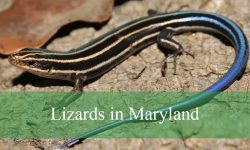Missouri boasts a rich array of butterfly species. This guide presents 45 diverse types, such as the Monarch, Painted Lady, and Red Admiral, highlighting their unique characteristics and behaviors. Explore the intricate patterns of the Viceroy, the migratory habits of the Red Admiral, and the stunning colors of the Eastern Comma. Uncover the fascinating world of these delicate creatures as they grace the Missouri landscapes with their beauty and grace.
Different types of Butterflies of Missouri
Checkered White
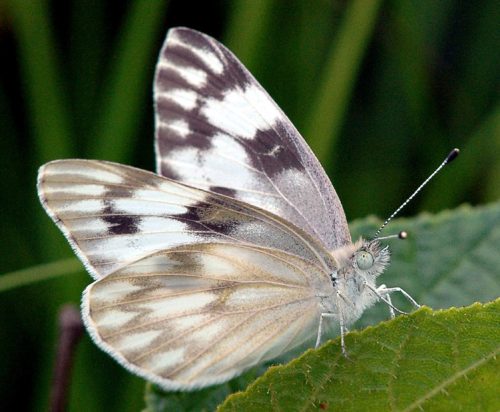
Checkered Whites, scientifically known as Pontia Protodice, have 1-2 inch wingspans. Males display dark grey markings, while females feature checkered patterns on fore- and hindwings. Notably, they utilize UV signals for communication and mate selection. Females strategically lay eggs on host plant fruits or stems, with larvae showing a preference for flowers or fruits. Common in Missouri, these butterflies thrive in sunny, open areas such as deserts, plains, and dry grasslands, as well as in man-made locations like airports and railroads.
Horace’s Duskywing
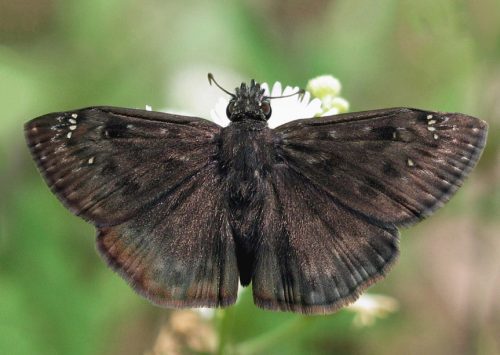
Horace’s Duskywings, or Erynnis Horatius, boast 1.5-1.75 inch wingspans. Males flaunt dark brown hues with hints of white and yellow, while females exhibit light brown shades with distinctive large spots. Their rapid, darting flight distinguishes them, often seen in open fields, oak woodlands, and sunlit dirt roadsides. Male butterflies perch on slopes, awaiting females about a foot above ground. Caterpillars construct leaf nests, feeding on saplings, and the final brood hibernates through winter, making them among the first spring sightings.
Peck’s Skipper
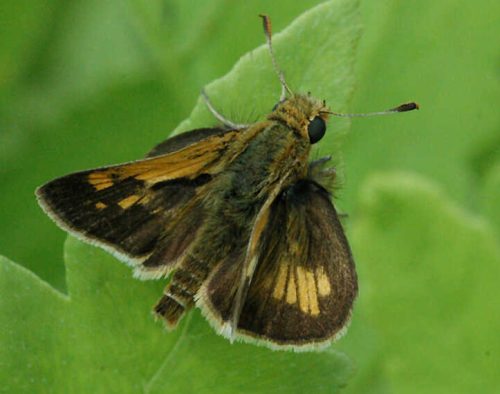
Peck’s Skipper, scientifically Polites Peckius, boasts 1-1.25 inch wingspans. Identified by yellow-spotted hindwings over a dark brown base and reddish/orange patches from above, females tend to be darker. These skippers frequent Missouri’s meadows, parks, prairies, and vacant lots, favoring open spaces abundant with nectar flowers and sunlight. Males bask in the sun, forewings open and hindwings horizontal, awaiting potential mates. Daytime mating precedes the female laying eggs individually on host plants, with caterpillars feeding on bluegrass, rice cutgrass, and other grasses.
Zabulon Skipper
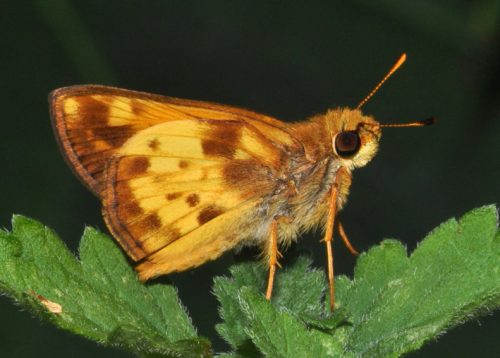
The Zabulon Skipper, or Lon Zabulon, features a 1-1.5 inch wingspan with distinct characteristics, such as yellowish-orange hindwings and brown-edged wings. Males display yellow hues with hints of orange and a dark brown border from above, while females combine purplish black and brown bases with yellow and white angular spots and a zigzag pattern.
Thriving in Missouri, they inhabit woodland edges, roadsides, and stream peripheries, adapting readily to parks, gardens, and suburban environments. Typically, males wait for females perched on branches or flowers, engaging in courtship during the afternoon or occasionally in the morning. Female Zabulon Skippers lay eggs individually on the underside of host plant leaves, aiding as important pollinators for various plant and flower species in their extensive habitat.
Zebra Swallowtail
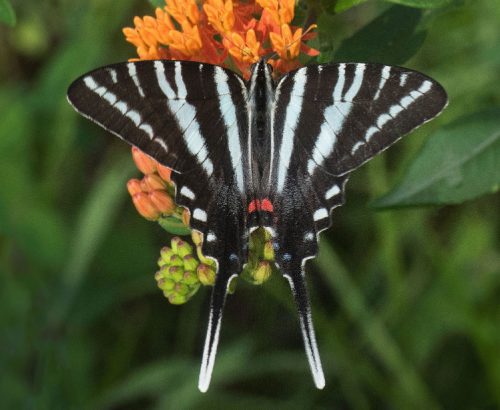
The Zebra Swallowtail, known as Eurytides Marcellus, boasts 2.5-3.5 inch wingspans with distinctive red body patches and hindwing stripes. Summer specimens exhibit black hues with zebra-like white bars, while spring ones feature bolder white patterns. Beloved by enthusiasts, they frequent Missouri’s broadleaf woodlands, swamps, and riversides rich in pawpaw trees, occasionally venturing into open fields for nectar. Despite their beauty, their caterpillars possess a secret defense mechanism. An orange gland, the Osmeterium, emits a strong odor to deter predators.
Eastern Giant Swallowtail
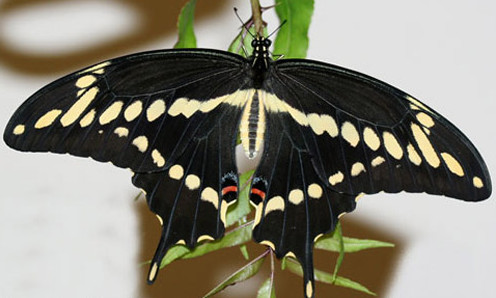
The Eastern Giant Swallowtail, or Heraclides Cresphontes, exhibits 4-6.5 inch wingspans, featuring dark brown to black coloring above and yellow highlights. Thriving in Missouri, they frequent deciduous forests, suburban gardens, and flower-rich meadows, their size and striking appearance making them a delightful backyard sight. Males actively seek females near host plants, using courtship displays before mating. Females lay eggs on leaf tips. Larvae resemble small brown snakes, employing an Osmeterium, an orange/red structure resembling a snake’s tongue, emitting a noxious odor when threatened.
Silver-Spotted Skipper
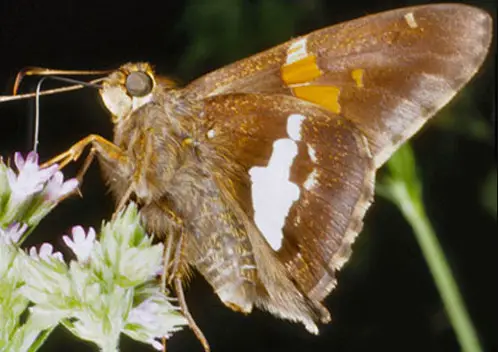
The Silver-Spotted Skipper, or Epargyreus Clarus, flaunts 1.75-2.25 inch wingspans with a prominent silver patch on the hindwing’s central part. Thriving in Missouri, they exhibit a diverse diet, utilizing their long tongues to feed on mud, flowers, and occasionally animal feces. Typically found at forest edges abundant with nectar, males perch on elevated vegetation, engaging in jerky flights to court females. Post-mating, females lay eggs on host plants. Caterpillars employ innovative leaf-cutting techniques, forming protective silk-bound tubes during the day, while night feeds occur outside. When threatened, caterpillars emit a defensive green chemical and disperse their scent to confuse predators.
Least Skipper
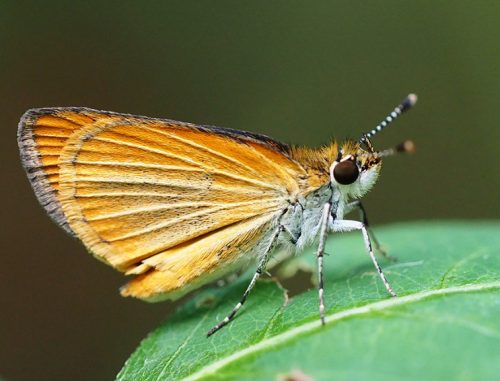
The Least Skipper, or Ancyloxypha Numitor, showcases 0.75-1 inch wingspans with dark brown hues and notable upper wing orange patches. Common in Missouri’s moist, open regions, they frequent grassy habitats like marshes, streams, ditches, fields, and hillsides, laying eggs on grass blades. Newly hatched larvae seek protection by rolling themselves within the grass. Active male Least Skippers tirelessly patrol grassy areas, seeking females for mating. However, females occasionally reject advances by dropping and positioning their wings beneath their bodies.
Pipevine Swallowtail
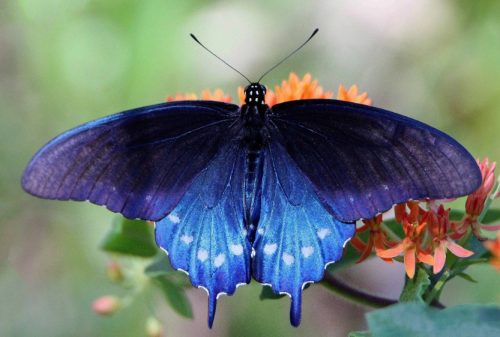
The Pipevine Swallowtail, known as Battus Philenor, boasts 2-3 inch wingspans, predominantly black with vibrant metallic blue edges and orange-white spots underneath. Dynamic in Missouri, they forage for nectar, favoring pink and purple flowers like Phlox. Males actively pursue females for mating, after which females lay eggs on the undersides of host plants, typically in the Aristolochia family such as Virginia Snakeroot and Dutchman’s pipe. Unpalatable to predators, these butterflies possess a defense mechanism similar to other species.
Sachem
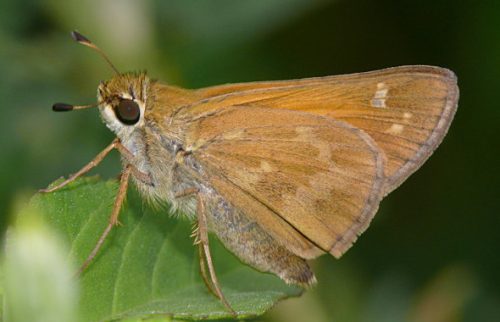
The Sachem, or Atalopedes Campestris, displays 1-1.5 inch wingspans. Males exhibit dull orange forewings with brown edges and shadowy yellow hindwings marked with a distinctive brown area and pale spots. Females feature dark brown forewings with orange centers, black patches, and white windows, while their hindwings bear brown hues with V-shaped pale spots.
Thriving in sunlit open areas such as pastures, fields, suburban lawns, and gardens, males adopt a passive role during mating, perching on or near the ground until chosen by females. After mating, females lay eggs on dry grass blades, and the caterpillars secure themselves within leaves for protection while feeding on grass blades. Recognizable by their whirling flight pattern, Sachems, along with Whirlabouts and Fiery Skippers, are playfully dubbed the “three wizards” by lepidopterists.
Common Checkered-Skipper
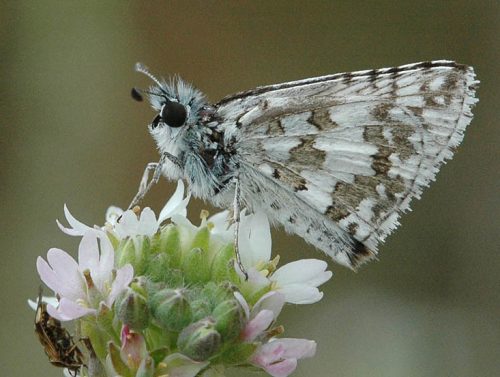
The Common Checkered-Skipper, known as Burnsius Communis, flaunts 0.75-1.25 inch wingspans with faded white hues, tan bands, and a black or brown hindwing edge. Notably, they feature a distinctive black and white checkered pattern from above. This butterfly, commonly spotted in Missouri, favors Mallow as its primary host plant, thriving in pastures, open fields, and disturbed sites, frequently seen near roads. Males actively seek suitable females for mating, leading to the laying of pale green eggs on the host plant’s soft parts. Upon hatching, caterpillars consume the host plant, curling leaves for winter protection.
Little Sulphur
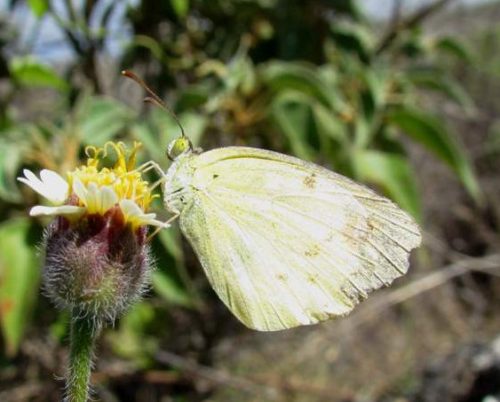
The Little Sulphur, or Eurema lisa, boasts a 1-1.5 inch wingspan, with males exhibiting bright yellow wings with black borders or tips, while females feature pale yellow wings with dark speckles. Their caterpillars sport deep green hues with thin cream stripes on each side.
In Missouri, they frequent disturbed open areas such as roadsides, vacant lots, and hiking trails. Often referred to as Little Yellows, they are attracted to local aster varieties for nectar and utilize partridge pea as a host plant for their caterpillars. While present year-round in warm climates, they’re typically sighted from late June to early October in northern regions.
Cloudless Sulphur
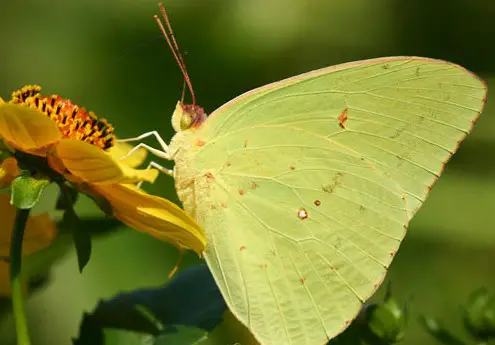
The Cloudless Sulphur, or Phoebis sennae, boasts a 2.2-2.8 inch unmarked, bright lemon-yellow wingspan. Highly recognizable in Missouri, they thrive abundantly, exhibiting a lack of shyness around humans. Predominantly pure yellow, they may display small white eyespots rimmed in dark red on their upper wings. Despite not being classified as threatened, habitat loss from overdevelopment has impacted their population. Planting native flowers can aid in attracting these cheerful butterflies and support their conservation.
Clouded Sulphur
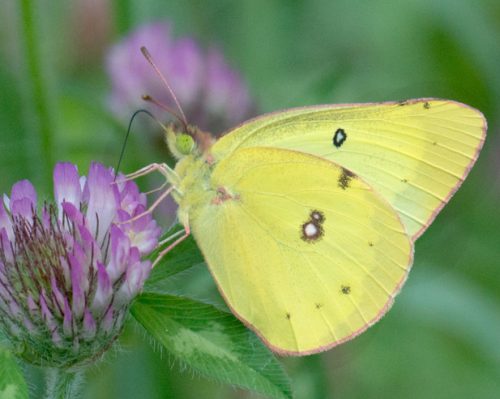
The Clouded Sulphur, or Colias philodice, displays a 1.75-2.75 inch wingspan with two color forms: one white with a light green tint and one yellow. Both variations feature a red-ringed eyespot and pinkish wing borders. Abundant in Missouri, they breed prolifically and adapt to diverse habitats, often seen in roadsides, parks, and gardens. Distinguishable by their erratic, wobbly flight, they share habitat with their kin, the Orange Sulphur, characterized by their jerky flight pattern. Interestingly, only female Clouded Sulphurs exhibit the white morph, while males remain consistently yellow.
Orange Sulphur
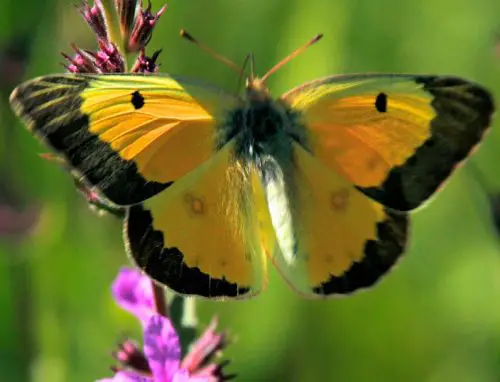
The Orange Sulphur, or Colias eurytheme, boasts a 1.5-2.5 inch wingspan with bright yellow-orange coloring, accentuated by black wing borders and irregular spots. In Missouri, they frequent sunny roadsides, meadows, and gardens, nourishing themselves and laying eggs on the host plant Alfalfa, earning the nickname “Alfalfa butterfly.” Recognizable by their low, erratic, jerky flight, they are commonly sighted in urban and suburban areas throughout spring and summer.
Cabbage White
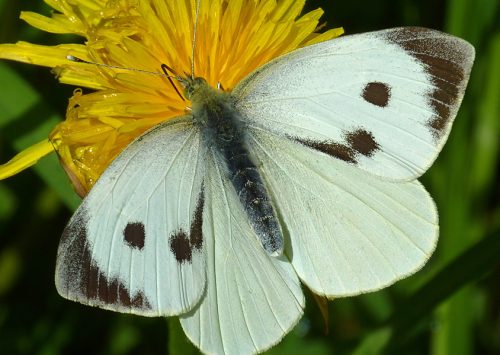
The Cabbage White, or Pieris rapae, showcases a 1.25-2 inch wingspan, light green to white wings with black tips and dots. Agile in diverse Missouri habitats, they avoid dense forests, thriving even in large cities. Active in summer, their caterpillars, known as Cabbage Worms, pose a threat to cabbage, kale, and other brassica plants. Given their invasive nature, diligent plant protection is essential, as they’ve become one of the most destructive species to crops in the region, introduced through food and agricultural trade.
Spicebush Swallowtail
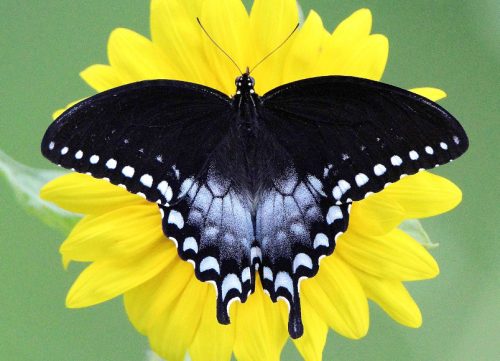
The Spicebush Swallowtail, or Papilio troilus, displays a 3-4 inch wingspan, dark brown to black with cream-colored wing edge spots and greenish-blue or bright blue hindwing patches. Thriving in forests, swamps, and unused fields, they remain active from late spring to early fall. Attract them with azaleas or jewelweed for nectar. Their caterpillars, known for their distinctive appearance, favor white sassafras and spicebush. Notably, they can regulate body temperature, enabling activity in cooler temperatures compared to other Missouri swallowtails.
Eastern Tiger Swallowtail
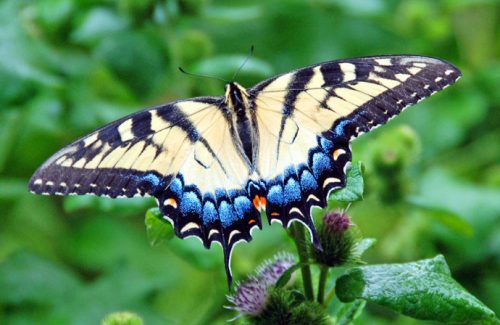
The Eastern Tiger Swallowtail, or Papilio glaucus, flaunts a 3.5-5.5 inch wingspan. Males boast vibrant yellow hues with black stripes and borders, while females exhibit two color forms: light, slightly darker yellow with pronounced black markings, and dark, nearly all-black with light blue speckling on the lower wings. Renowned for its striking appearance, this solitary flier frequents Missouri, occasionally seen in male gatherings “puddling” on wet ground. Planting tall-stalked flowers like phlox, ironweed, and lilac can attract them to home gardens. Notably, the caterpillar’s defense strategy involves prominent eyespots and an enlarged head, mimicking a threatening snake to deter predators.
Black Swallowtail
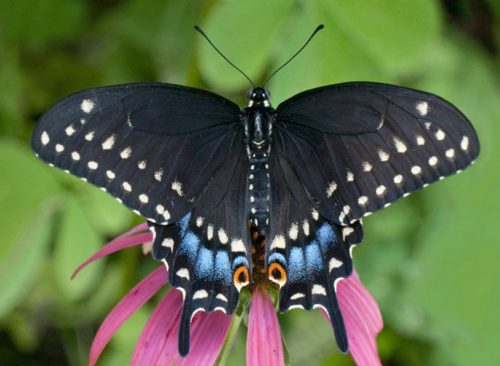
The Black Swallowtail, or Limenitis archippus, showcases a 2.5-4.25 inch wingspan, featuring black hues with rows of light yellow spots, a red-orange eyespot, and blue spots on each hindwing. Common in Missouri gardens, they favor flower nectar and often visit garden plants. Their green caterpillars rely on cultivated herbs like parsley and mint as host plants, potentially posing risks if they feed excessively. Evolved mimicry resembling the toxic Pipevine Swallowtail allows them to camouflage and evade predators effectively.
Banded Hairstreak
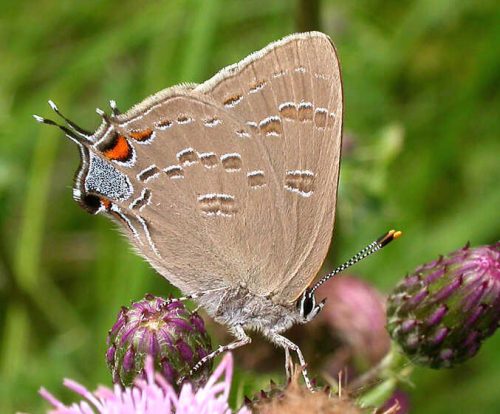
The Banded Hairstreak, or Satyrium calanus, displays a 1-1.25 inch wingspan, featuring varying brown to slate gray hues, black-bordered red dots along the wings’ outer edges, white stripes, and a blue patch near the wing tails. Typically found in forested areas or sunny clearings near woods, they are drawn to nectar plants, making sightings easier near wooded regions. Planting dogbane or meadowsweet can further attract them. Active for approximately four weeks in early summer, they mate once during this period, with eggs surviving through summer, fall, and winter, hatching into caterpillars come spring. Look for them around oak, walnut, and hickory trees.
Gray Hairstreak

The Gray Hairstreak, or Strymon melinus, features a 1-1.5 inch wingspan, displaying slate gray hues with a solitary bright orange spot on each lower wing. Notably, their underside wings bear light gray shades with a black and white stripe. They are commonly found in open areas such as roadsides, unused pastures, and rural meadows, with their caterpillars utilizing various plants as hosts, thriving in diverse habitats. Sporting thin, long wing tails resembling hairs, they employ this adaptation as a defensive mechanism, diverting predators’ attention from the body. Mimicking a head with antennae and utilizing eyespots for distraction, the Gray Hairstreak buys time to escape from potential threats.
Eastern Tailed-Blue
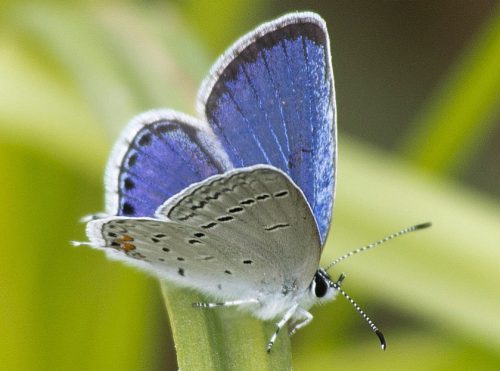
The Eastern Tailed-Blue, or Cupido comyntas, showcases a 0.75-1 inch wingspan. Males exhibit brilliant blue hues with a brown border and white edges, while females display grayish-brown shades with white edges. Both genders feature one or two small orange spots above the wing tails. Easily spotted in Missouri’s vacant lots, pastures, and gardens, they are one of the most abundant species and readily drawn to flowers. Their distinguishing features include delicate, hair-like tails on the hindwings, though these often break off, and a silvery-blue underside.
American Snout
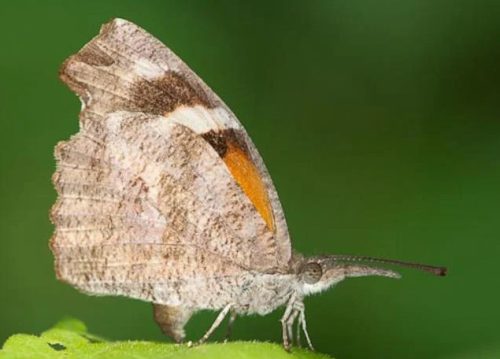
The American Snout, or Libytheana carinenta, boasts a 1.5-2 inch wingspan, presenting brown hues with orange and white patches resembling a dead leaf. Its distinctive long, beak-like “snout” serves as camouflage, mimicking a leaf. Unparalleled in Missouri, this unique feature aids its concealment. While they migrate north annually, they remain scarce and elusive due to their exceptional disguise. Massive migratory groups occasionally darken the sky during sightings.
Little Wood Satyr
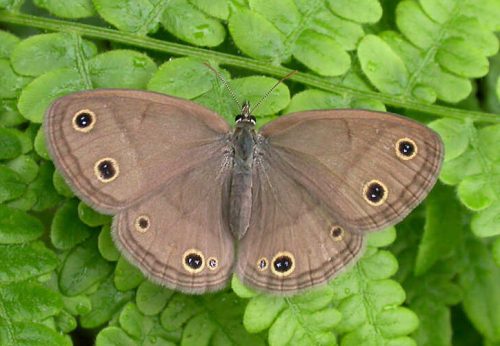
The Little Wood Satyr, or Megisto cymela, displays a 1.5-1.9 inch wingspan, characterized by brown hues and multiple yellow-ringed eyespots. Often found in shady woodlands, clearings, and nearby brushy areas, they prefer lower perches like leaf litter rather than branches or tall grass. Unlike other butterflies, they don’t seek out flowers due to their diet. Instead, they are attracted to animal dung, rotting mushrooms, and old sap flows. It’s best to observe this species in its natural habitat rather than attempting to attract it to your yard.
Common Wood-Nymph
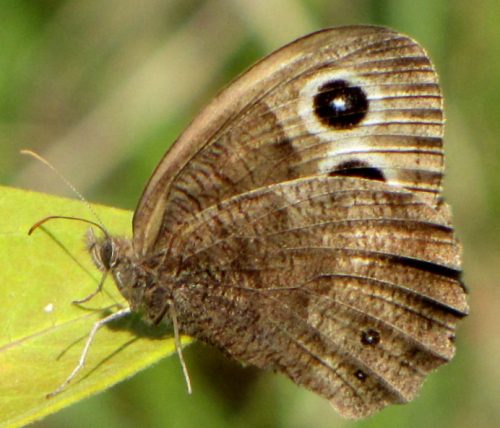
The Common Wood-Nymph, or Cercyonis pegala, showcases a 2-3 inch wingspan, typically presenting shades of brown with dark eyespots. It can be found in various habitats, including open forests, meadows, agricultural fields, and salt marshes. Their caterpillars hatch late in fall, hibernate through winter, and feed on grass, particularly Kentucky Bluegrass. During late summer and early fall, they are most active. While they occasionally consume flower nectar, they prefer rotting fruit or decaying plants. With their preference for a common lawn grass, you may not need to plant anything new to attract this species.
Silver-Bordered Fritillary
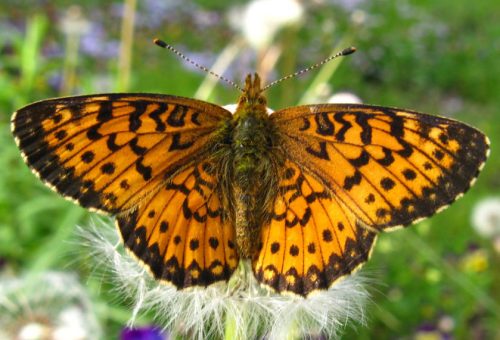
The Silver-Bordered Fritillary, or Boloria selene, features a 1.6-2.1 inch wingspan with bright orange hues, irregular black markings, and a thin white edge. Its wings sport a thick black border with orange dots and metallic, silvery dots on the underside. This species prefers wet grasslands, facing a decline due to habitat disruption from agricultural fields. To attract them, consider planting violets for their caterpillars and thistle for nectar. Keep an eye on the ground for their swift, low flights characterized by streaks of orange.
Meadow Fritillary
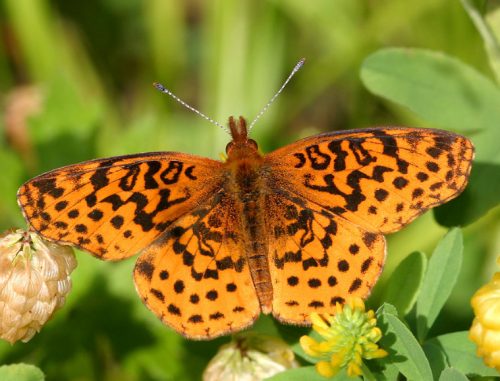
The Meadow Fritillary, or Boloria bellona, boasts a 1.5-2 inch wingspan with yellow-orange hues and dusky black splotches. Its muted underside resembles a dead leaf, aiding in camouflage. This brush-footed butterfly is common in eastern Missouri, active throughout the summer. To attract them, consider planting aster flowers like Black-eyed Susans, daisies, and sunflowers in your garden.
Great Spangled Fritillary
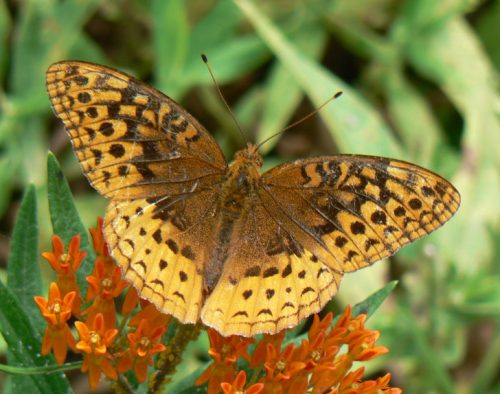
The Great Spangled Fritillary, or Speyeria cybele, has a 2.5-3.5 inch wingspan with an orange hue and a distinctive web-like pattern of black lines and dots. It thrives in open, sunny areas like pastures and meadows, often congregating in large numbers around milkweed or violet fields. This non-migratory species features caterpillars that hibernate through winter, emerging alongside the new growth of their host violet plants in spring. After mating, males typically perish weeks before females, who, after feeding for a few weeks, lay eggs and also meet their end.
Variegated Fritillary
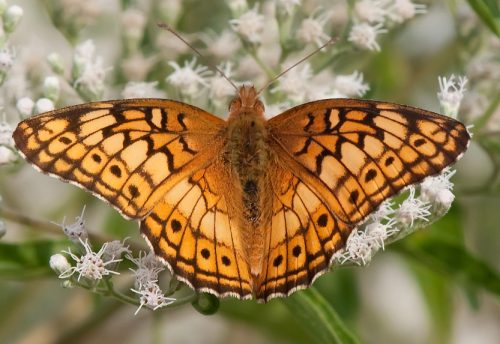
The Variegated Fritillary, or Euptoieta claudia, boasts a 1.75-2.25 inch wingspan with tawny brown to burnt orange coloring marked by black dots and lines. Look for them in Missouri’s meadows, open lots, and fields. To attract them to your garden, plant flowers like butterfly weed, mint, and sunflowers, and provide host plants such as violets, pansies, and passionflower for their caterpillars. The Variegated Fritillary’s chrysalis is a stunning sight, resembling an exquisite jeweled pendant with its pearly white color and shiny gold spikes.
Common Buckeye
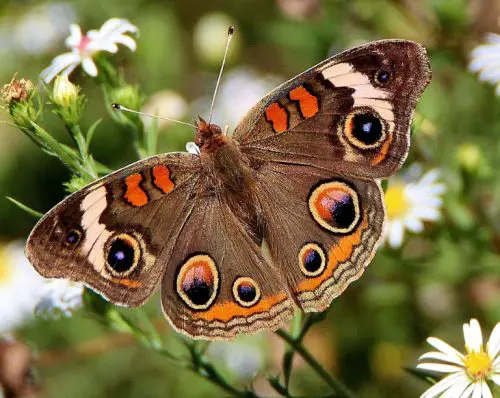
The Common Buckeye, or Junonia coenia, boasts a 2-2.5 inch wingspan with brown coloring, distinctive orange bars, and eye-catching black and white rings that outline several prominent eyespots. Look for them in Missouri’s open spaces like pastures, old fields, and roadsides. While they’re cautious and hard to approach, they fly close to the ground and often perch for photo opportunities. In the southern U.S., Common Buckeyes don’t adhere to a specific mating season, as they can reproduce continuously due to the favorable climate. However, in northern states, they migrate south for the winter and return in the spring, producing two to four generations each season.
Eastern Comma
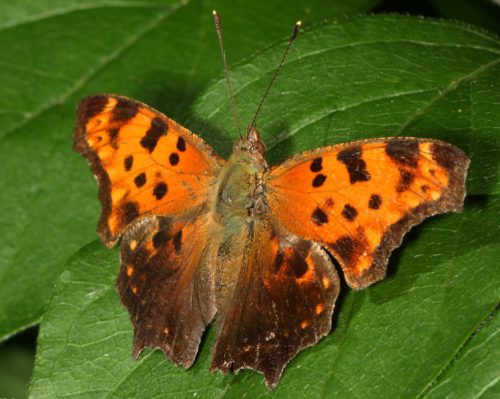
The Eastern Comma, or Polygonia comma, has a 2-2.5 inch wingspan with orange coloring and black mottling on the upper wings, while the lower wings are predominantly black with some orange spots. They inhabit deciduous forests, suburban yards, and parks, with Nettle and Elm Trees serving as preferred hosts for their caterpillars. Adults aren’t drawn to flowers but instead feed on decaying fruit, carrion, and animal waste. Despite this unappealing diet, they’re quite common and can often be spotted. Interestingly, Eastern Commas hibernate as adults, seeking shelter in log piles, tree hollows, and even human-made structures during winter. Their mating season begins in early spring, with new generations becoming active in early summer.
Question Mark
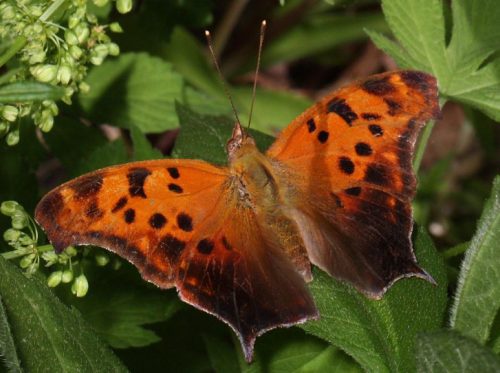
The Question Mark, or Polygonia interrogationis, boasts a 2.25-3 inch wingspan with deep orange coloring, black spots, and a lavender edge. You can find them in moist woodland and forest edges, particularly where elm trees and nettles grow. Their vibrant upper-wing coloration contrasts with a mottled brown underside, providing effective leaf-like camouflage. Their intriguing name stems from a light marking on the underside, resembling a rudimentary question mark.
Pearl Crescent
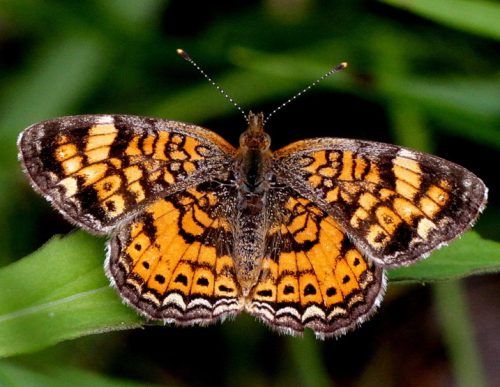
The Pearl Crescent, or Phyciodes tharos, is recognizable by its 1.25-1.75 inch wingspan, adorned with intricate black patterns resembling lace against a bright orange backdrop. Look for them near moist ground in various habitats like forest edges, fields, meadows, and gardens. Their caterpillars thrive on Aster plants, making these a great addition to any butterfly-friendly garden.
Mourning Cloak
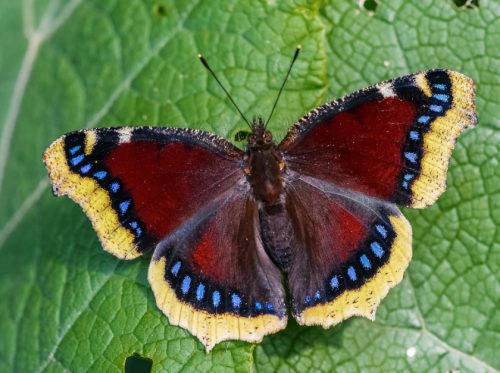
The Mourning Cloak, or Nymphalis Antiopa, boasts a 3-4 inch wingspan with distinctive black wings showcasing an iridescent sheen, highlighted by a yellow border and purple spots. Their habitat ranges from deciduous forests to suburban yards and parks, making them adaptable but somewhat elusive. They’re known to survive long winters and live up to ten months, making them one of the longest-lived butterfly species.
Red-Spotted Purple
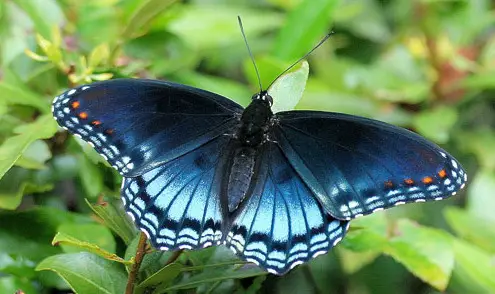
The Red-Spotted Purple, or Limenitis arthemis astyanax, flaunts 3-4 inch wings with iridescent blackish-blue coloration and red-orange spots, mimicking the toxic Pipevine Swallowtail. These beautiful butterflies display a variety of forms, including the White Admiral in the north. They feed on carrion, sap, and rotting fruit, making these items a great lure for them during their active season from April to October.
Hackberry Emperor
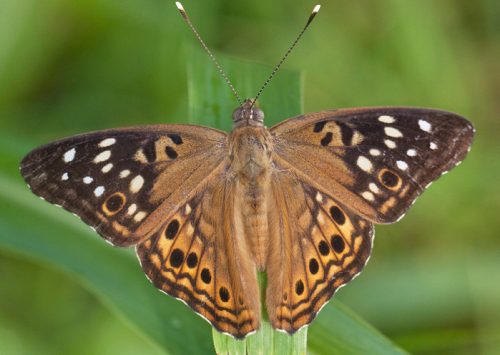
The Hackberry Emperor, or Asterocampa celtis, has a 2-2.75 inch wingspan with a striking amber brown and nearly black pattern, highlighted by orange-ringed eyespots. These curious butterflies avoid flowers, instead seeking sodium from human skin, as well as minerals from soil, rocks, and pavement. They also feed on sap, dung, carrion, and rotting fruit and drink water from rain puddles.
Viceroy
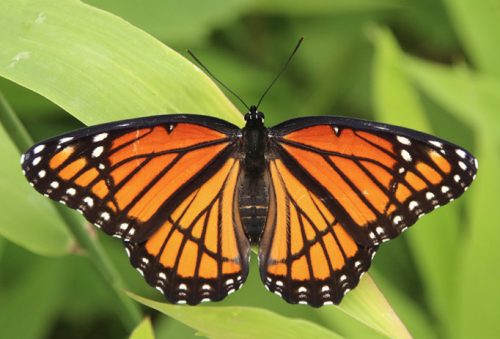
Viceroys, or Limenitis archippus, have a 2.5-3.25 inch wingspan with deep orange coloring and distinctive black edges and veins. Look for the black line on the bottom wing to differentiate them from Monarchs. Viceroy caterpillars, with their greenish-brown, spiny appearance, hibernate in rolled-up leaves and emerge during the next breeding season.
American Lady

Look for American Lady butterflies with a 1.75-2.5 inch wingspan near flowering plants in open Missouri landscapes. Their brilliant orange coloring, dark borders, and distinctive eyespots serve as a defense mechanism. These nervous butterflies are quick to take flight at any sign of disturbance.
Monarch
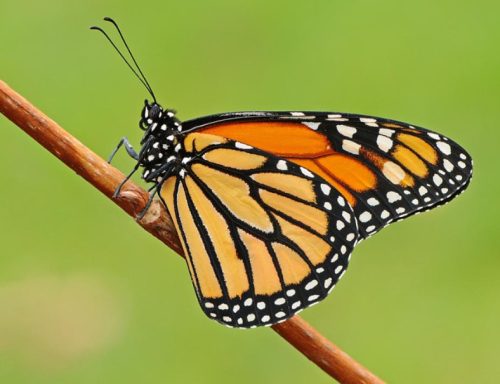
Keep an eye out for Monarch butterflies, with a 3.5-4 inch wingspan, in Missouri. Their iconic stained-glass pattern, white dots, and milkweed reliance are well-known. Supporting Monarchs with milkweed planting can also benefit other pollinators, especially during their migration in mid-September.
Painted Lady
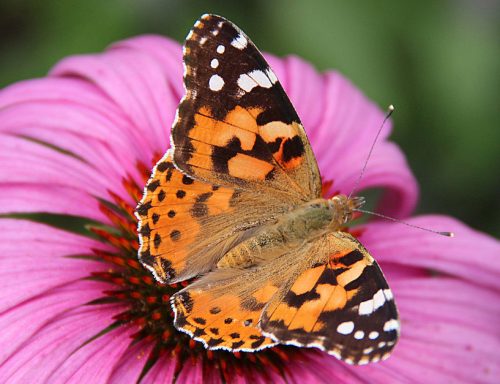
Painted Lady butterflies in Missouri have a 1.75-2.5 inch wingspan and migrate to Mexico for the winter. They’re adaptable and often appear in varying numbers. Their unique year-round mating habit is influenced by their migration pattern. Look for them in undisturbed open areas.
Red Admiral
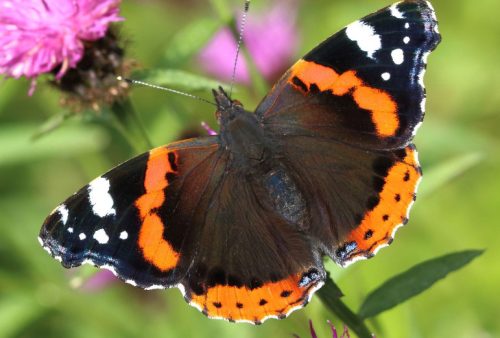
The Red Admiral is a widespread Missouri butterfly with a 1.75-2.5 inch wingspan. Look for it near forest edges and moist areas. They enjoy fermented fruit and have a unique migratory pattern, moving south in winter and returning north in late spring. Calm and approachable, they often land on people.
People Who Read This Also Read:





